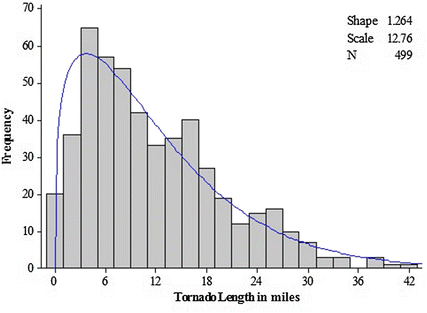Sometimes tornadoes just don’t get the hint. You can yawn, turn on the TV, look at your watch, take the dog out for a walk… but they persist. You could also simply ask them to leave. But, like tired toddlers, they have the power to destroy your home. So you tread lightly.
Also like toddlers, they rarely travel in a straight line. The forces that steer them are complex, sometimes leading to wild paths.

Despite Hollywood’s recent fever dream, we have no real way to stop a tornado once it starts. Nature has to take its course. And most of the time, it’s a short but violent one.
Waltzing Tornadoes
The average tornado lasts <10 minutes and covers a path of around 5.6 km (3.5 miles). However, the median duration of a tornado is much shorter - lasting approximately 2 minutes and traveling just under 1 km (0.6 miles).
What’s the difference? The average of a set of numbers treats all values equally, while the median is the middle value when the numbers are arranged in order. It couldn’t care less if the longest tornado path is 1 mile or a bazillion miles.
Thus, medians are less affected by extreme values. This makes it a more useful statistic when dealing with outliers. For example, it is often used in home prices and pay scales, where a single extremely wealthy individual can skew the average.

This is a histogram of a sample of 499 tornado path lengths from Caldera, et al. (2018). Most lengths are clustered around the shorter end of the scale (0-18 miles). But there are some really long paths. Those long ones have a strong influence on the mean, even though they are relatively rare.

And this plot shows that tornado path length distribution does not follow a linear pattern. The differences between path lengths vary, with much greater variability seen in paths shorter than 50 km compared to longer ones. Because of this skewed distribution, the mean is not a reliable measure of the central tendency for tornado path lengths. The median provides a more accurate representation in this context.
Long-Track Tornadoes
Thus ends the stats 101 portion of this newsletter. Why are we talking about this? Partially (mostly?) because I enjoy discussing basic statistics about as much as I dislike talking about relative humidity. But also because a fascinating paper was recently published on the environmental conditions associated with long-track tornadoes.
A research team led by Dr. Jerry M. Straka statistically analyzed the paths of 48,212 tornadoes in the United States from 1979 to 2022. Their goal was to identify trends and relationships in the environmental conditions that contributed to long-track tornadoes, which could help forecasters.
They began with a public tornado database hosted by the Storm Prediction Center (SPC). Because they are rock star researchers,1 they went so far as to manually verify all tornado paths ≥30 miles using additional databases and publications. They then examined over 200 background environmental variables for each tornado, using data from the ERA5 database. ERA5 is a global climate reanalysis dataset produced by the European Centre for Medium-Range Weather Forecasts (ECMWF). It provides detailed hourly data on atmospheric, land, and oceanic conditions, including variables such as temperature, wind, precipitation, and humidity (ugh).
Thermodynamic and Kinematic Parameters
The authors categorized the variables into two groups: thermodynamic and kinematic. The former represents environmental conditions in the atmospheric background (e.g. temperature and CAPE). The latter represent conditions related to the movement of the atmosphere (e.g., wind speed and direction). They found the thermodynamic variables were not often significantly predictive of long-track tornadoes, with a few exceptions mostly related to very long-track tornadoes of >70 mi lengths.
However, kinematic parameters were more helpful. For example, higher tropospheric wind speeds were positively associated with longer-track tornadoes.

The plot on the left displays wind speeds at 9km altitude (y-axis) against different groupings of track lengths (colored boxes) and tornado intensity (cyan boxes). The colored boxes illustrate that stronger winds are generally associated with longer tracks. They also reveal greater variability (the vertical lines above and below the boxes) in wind speeds for shorter-track tornadoes. The scatterplot on the right presents the same data in a different format. Notice the ascending straight line, which highlights the relationship between wind speed and path length—specifically, as wind speeds increase, the tornado path length also increases.
Putting This to Use
They applied this type of analysis to many variables to find the ones that mattered. Then, they combined all of those into an unholy smörgåsbord composite variable called the long-track tornado parameter (LTTP). It consists of both thermodynamic and kinematic variables that have shown a relationship with tornado track length. They are weighted, multiplied together, and then normalized.
Compare this plot to the one shown earlier. The trends are similar (higher LTTP leads to longer paths and more intense tornadoes), but they are steeper. This means LTTP does a better job of predicting long-track tornadoes than 9000m wind speed alone. This is one of the advantages of composite variables.
The authors caution forecasters against relying too heavily on any single parameter when evaluating tornado track potential. (This brought to mind many social media storm chasers who fixate on CAPE and other metrics instead of considering the broader context.) They emphasize that no single factor is sufficient to predict a long-track tornado. However, combined with prior research, this study aims to help forecasters and researchers better understand how long a tornado is likely to persist before it finally gets the hint.
And Now for Something Completely Different
I adore classical music. And there are few pieces that move me as much as Chopin’s Prelude, Op. 28, No. 15, a.k.a. “raindrop”.
Chopin resisted giving descriptive titles to his music and vehemently denied that this piece was inspired by rain falling on a roof. However, his partner claimed she found him composing it during a rainstorm, and the interpretation has stood the test of time. More recently, researchers sat in the room where he wrote it during a rainstorm. They reported that they could indeed hear echoes of his music in the rain, unique because of the specific structure and composition of the roof and windows.
Most of the time, only violent and intense weather is represented in music. Think of the gods-at-play thunderstorm in Beethoven’s Pastoral Symphony and its famous scene in Disney’s Fantasia. Rarely do we hear the calmer, more serene yet just-as-beautiful weather phenomenon. There are no popular songs about droughts (that I know of!) or languid summer breezes. But at least we do have an iconic one about rainbows.
We acknowledge Dr. Swarndeep Gill and Beth Mills for additional contributions.
Seriously, Dr. Straka is very well regarded in the field and even has his own Wikipedia page.








"Summer Breeze", by Seals and Crofts (1972).